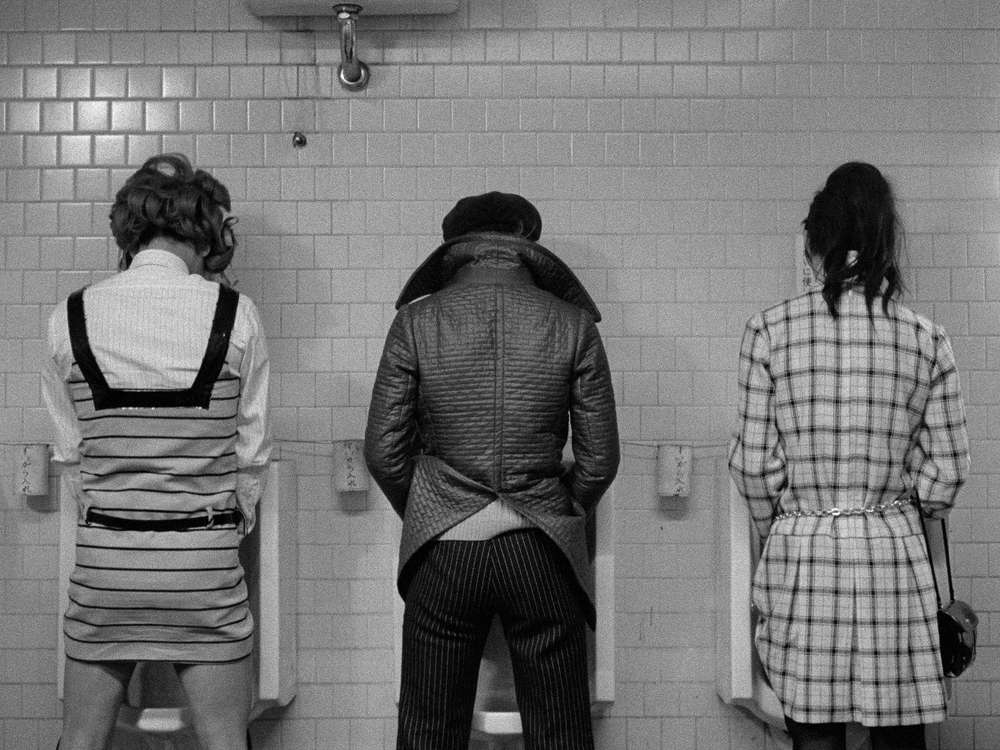CERCA
2 giugno 2019, 22.30 / Cinema De Seta
carte postale à Serge Daney
Il funerale delle rose / Bara no sōretsu
Toshio Matsumoto
Giappone 1969 / 105’ / v.o. sott. it. / introduce Lionel Baier

[ITA]
Eddie e Leda sono due travestiti che si contendono l’amore di Gonda, proprietario del gay bar Genet, dove lavorano entrambi. Ambientato alla fine degli anni Sessanta in una Tokyo notturna e abbagliante popolata da studenti riottosi, giovani alla ricerca di un’esistenza lontana dai vincoli sociali e dive da burlesque che si trasformano in principesse del boudoir, Il funerale delle rose è un’opera chiave della Nouvelle Vague giapponese: una ferita ancora pulsante che mescola liberamente interviste documentarie, meta-film brechtiano, nefaste premonizioni edipiche e grafismo metropolitano.
Un ritratto schietto, erotico e non apologetico di una comunità sotterranea ma sempre più scalpitante, pervaso e alimentato dalla follia di sbornie lisergiche, chitarre fuzz e mascara in gran quantità che hanno influenzato l’Arancia meccanica di Kubrick.
[ENG]
Eddie and Leda are two transvestites who compete for the love of Gonda, owner of the gay bar Genet, where they both work. Set at the end of the 1960s in a nocturnal and dazzling Tokyo populated by riotous students, youngsters yearning for a life far from social ties and burlesque divas that turn into princesses of the boudoir, Funeral Parade of Roses is a key work of the Japanese New Wave: a throbbing cinematic wound that mixes documentary interviews, Brechtian film-within-a-film, Oedipal premonitions of disaster and metropolitan graphism.
A frank, erotic and unapologetic portrait of an underground community that is increasingly jittery, fueled by the insanity of colossal booze, drugs, fuzz guitars and tons of mascara as well as a direct influence on Kubrick’s A Clockwork Orange.
Toshio Matsumoto
[ITA]
Regista, videoartista e critico cinematografico, classe 1932. È stato un pioniere del cinema sperimentale giapponese. Prendendo le mosse da una prassi di stampo documentaristico, ha creato opere radicali e uniche. Negli anni Sessanta, attraverso la riflessione teorica e la produzione filmica ha fondato il “neo-documentarismo”, forma documentaria che rifiuta la presunta natura oggettiva del mezzo provando a rivelare stati mentali e soggettivi. Nel 1961 con il mediometraggio Nishijin si aggiudica il Leone d’argento. Nel 1963 è la volta di Song of Stones, cortometraggio costruito attraverso il montaggio di una sequenza di fotografie. Realizzato nel 1969, Il funerale delle rose è il suo primo lungometraggio, girato pressoché in contemporanea con il corto seminale For My Crushed Right Eye. Negli anni Settanta si è avvicinato alla televisione e al video sperimentando ulteriormente i processi di manipolazione dell’immagine. Nel 1971 e nel 1988 ha realizzato altri due lungometraggi, rispettivamente Pandemonium e Dogra Magra. Si è spento nel 2017.
[ENG]
Born in 1932, he was a director, video artist and film theorist. He was a pioneer of Japanese experimental cinema. Starting from a documentary-style practice, he created radical and unique works. In the 1960s, through theoretical reflection and cinematic praxis, he coined “neo-documentarism”, a documentary form that rejects the alleged objective nature of the medium by trying to reveal internal mental states and subjectivities. In 1961 he won the Silver Lion with medium-length film Nishijin. In 1963 he directed Song of Stones, a short film built through the editing of a series of photographs. Made in 1969, Funeral Parade of Roses was his first feature, shot almost simultaneously with the influential short For My Crushed Right Eye. During the 1970s he approached television and video, further experimenting with the processes of image manipulation. In 1971 and in 1988 he directed two more feature films, respectively Pandemonium and Dogra Magra. He died in 2017.
Il funerale delle rose / Bara no sōretsu
Toshio Matsumoto
Giappone 1969 / 105’ / v.o. sott. it. / introduce Lionel Baier
screenplay Toshio Matsumoto
cinematography Tatsuo Suzuki
editing Toshie Iwasa
music Joji Yuasa
sound Mikio Katayama
cast Peter, Yoshio Tsuchiya, Osamu Ogasawara, Yoshimi Jo, Koichi Nakamura
producer Mitsuru Kudo
contact e.toshinari@cineliciouspics.com
contact d.marriott@cineliciouspics.com



